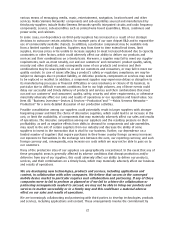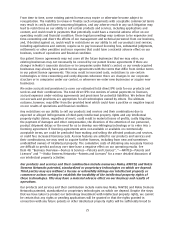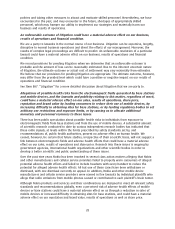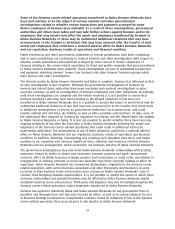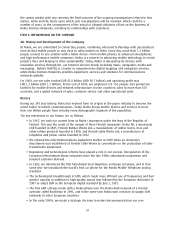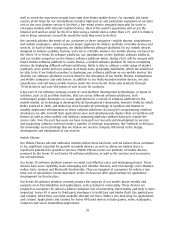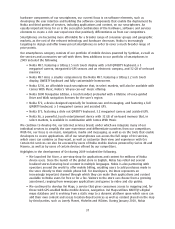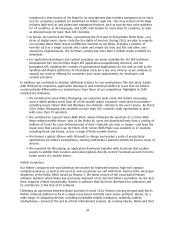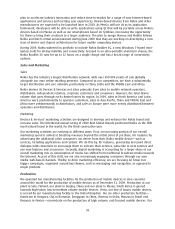Nokia 2009 Annual Report Download - page 34
Download and view the complete annual report
Please find page 34 of the 2009 Nokia annual report below. You can navigate through the pages in the report by either clicking on the pages listed below, or by using the keyword search tool below to find specific information within the annual report.We cannot predict with any certainty the final outcome of the ongoing investigations related to this
matter, when and the terms upon which such investigations will be resolved, which could be a
number of years, or the consequences of the actual or alleged violations of law on the business of
Nokia Siemens Networks, including its relationships with customers.
ITEM 4. INFORMATION ON THE COMPANY
4A. History and Development of the Company
At Nokia, we are committed to connecting people, combining advanced technology with personalized
services that enable people to stay close to what matters to them. Every day, more than 1.2 billion
people connect to one another with a Nokia device—from mobile phones to advanced smartphones
and high performance mobile computers. Nokia is a pioneer in advancing mobile technology to enrich
people’s lives and helping to drive sustainability. Today, Nokia is integrating its devices with
innovative services through Ovi, our Internet services brand, including music, navigation, media and
messaging. Nokia’s NAVTEQ is a leader in comprehensive digital mapping and navigation services,
while Nokia Siemens Networks provides equipment, services and solutions for communications
networks globally.
For 2009, our net sales totaled EUR 41.0 billion (USD 58.7 billion) and operating profit was
EUR 1.2 billion (USD 1.7 billion). At the end of 2009, we employed 123 553 people; had production
facilities for mobile devices and network infrastructure in nine countries; sales in more than 160
countries; and a global network of sales, customer service and other operational units.
History
During our 145 year history, Nokia has evolved from its origins in the paper industry to become the
world leader in mobile communications. Today, Nokia brings mobile devices and services to more
than one billion people from virtually every demographic segment of the population.
The key milestones in our history are as follows:
• In 1967, we took our current form as Nokia Corporation under the laws of the Republic of
Finland. This was the result of the merger of three Finnish companies: Nokia AB, a woodpulp
mill founded in 1865; Finnish Rubber Works Ltd, a manufacturer of rubber boots, tires and
other rubber products founded in 1898; and Finnish Cable Works Ltd, a manufacturer of
telephone and power cables founded in 1912.
• We entered the telecommunications equipment market in 1960 when an electronics
department was established at Finnish Cable Works to concentrate on the production of radio
transmission equipment.
• Regulatory and technological reforms have played a role in our success. Deregulation of the
European telecommunications industries since the late 1980s stimulated competition and
boosted customer demand.
• In 1982, we introduced the first fullydigital local telephone exchange in Europe, and in that
same year we introduced the world’s first car phone for the Nordic Mobile Telephone analog
standard.
• The technological breakthrough of GSM, which made more efficient use of frequencies and had
greater capacity in addition to highquality sound, was followed by the European resolution in
1987 to adopt GSM as the European digital standard by July 1, 1991.
• The first GSM call was made with a Nokia phone over the Nokiabuilt network of a Finnish
operator called Radiolinja in 1991, and in the same year Nokia won contracts to supply GSM
networks in other European countries.
• In the early 1990s, we made a strategic decision to make telecommunications our core
32


